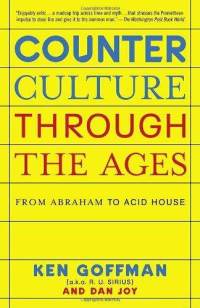
All through history there have been those who didn’t fit into mainstream culture — though they rebelled against the larger society around them, they often sought out others with similar beliefs, forming enclaves and subcultures within the larger group. Though we’ve all heard about the hippies and the 60s, the reality is that that movement was simply one of the most influential of countercultures, as well as one more successfully co-opted by mainstream capitalism than most. The flower children were descendents of a long line of freaks, weirdos, and rebels stretching back into farthest antiquity.
I love books that lead you to other reading — in Scribe’s fantastic book, The Tribes of Burning Man, he makes repeated reference to this book, Counterculture Through the Ages: From Abraham to Acid House by Ken Goffman and Dan Joy, in trying to define what counterculture is and how Burning Man fits in. This intrigued me enough to buy it on Kindle, and it in turn has led to further reading — I’ve looked up several classics referenced within its pages; it was through this book that I finally got around to reading the thought-provoking and hilarious Candide by Voltaire. By this measurement, the book is already a success — but how about the rest of its qualities?
“The mark of counterculture is not a particular social form or structure, but rather the evanescence of forms and structures, the dazzling rapidity and flexibility with which they appear, mutate, and morph into one and another and disappear.” –from Timothy Leary’s forward to Counterculture Through the Ages
Tracing the countercultural current through history is an ambitious goal, since countercultures themselves often resist documentation. The dominant culture represses others, meaning we may never hear about their tiny rebellious voices. Goffman, with help from Dan Joy, deliberately choose to focus on the most well-documented groups. Though books and artworks are “byproducts” of the real subversive work of counterculture, sticking to the road well-traveled allows the authors to better illuminate the common ground between them all. Rather than the impossible task of documenting every counterculture ever, the purpose of this book is to use historical groups to show us the roots and common characteristics of countercultures throughout history.
R.U. Sirius, a countercultural figure of note in his own right, shares not just the great things about these groups but also shows how they break down. He skillfully traces a continuous, albeit wandering path from the prehistoric myths of Abraham and Prometheus, through the Sufis and Zen Buddhists, all the way up to wild freaks of modern times. He shows how the ideas of one group influence the next, even if few hippies could have identified the ways in which their beliefs descended from Sufism or the thinkers of the Enlightenment.
Goffman’s analysis is insightful and sharp — we’ve all heard about the “failure” of the dream of the 1960s, for example, but this book has a very cogent and clear breakdown of the lasting successes of that chaotic period too. He’s not afraid to draw connections between almost anyone — few authors would seriously compare the Ramones to the likes of Pablo Picasso, but once made the links become clear and compelling. I came away from this book with a greater sense of how my life is part of a tapestry of freaks like me, stretching back thousands of years.
It is always a challenge for historians to relate modern movements to historical influences. I found the subtitle of Counterculture Through the Ages a bit misleading however — neither Acid House nor any aspect of the modern dance music movement merit more than a brief section alongside quick profiles of a half-dozen other modern groups. Those hoping for a look at how Burning Man fits into this historical picture will need to look elsewhere — such as Scribe’s book mentioned above.
I recommend this book to anyone fascinated by the rebels, iconoclasts, and eccentrics of our world. Whether you’re a Burner, an Anonymous Hacker, a Rainbow Kid, a Juggalo, or just a fascinated outsider you’ll come away with a better appreciation of where these movements come from and where they might be going in the future. Counterculture Through the Ages: From Abraham to Acid House is a brisk, funny, and most of all insightful book.
If you enjoyed this review, read more of Kit’s Writing or follow Kit on Twitter.